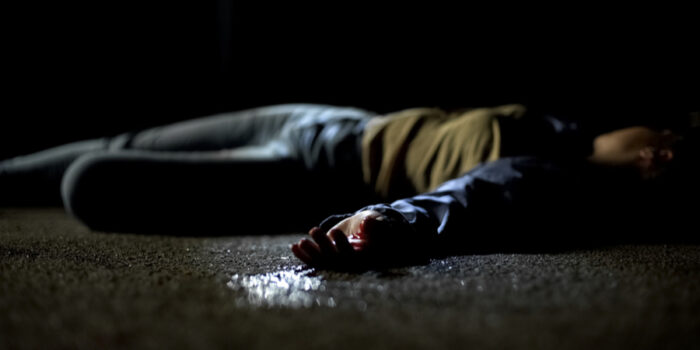Manslaughter is an illegal killing that does not require malice aforethought—intent to seriously damage or kill or an extreme, reckless disregard for life. Because there is no premeditated malice, manslaughter has less moral responsibility than first- or second-degree murder. (However, others contend that some cases of felony murder, a type of first-degree murder, include less blameworthiness than other cases of manslaughter.) As a result, while manslaughter is a serious crime, the sentence is often less severe than that for murder.
The two most common types of manslaughter are voluntary and involuntary manslaughter, sometimes known as first and second-degree manslaughter.
First Degree Manslaughter
A person is guilty of manslaughter in the first degree when, in circumstances indicating an excessive disregard for human life, they recklessly engage in action that puts another person in severe danger of death and therefore causes the death of another person. Manslaughter in the first degree in Connecticut Statutes 53a-55 is as follows:
- With intent to cause serious physical injury to another person, they cause the death of that person or a third person;
- With intent to cause the death of another person, they cause the death of that person or a third person under circumstances that do not constitute murder because they committed the proscribed act or acts while under the influence of extreme emotional disturbance. Except that the fact that homicide was committed while under the influence of extreme emotional disturbance constitutes a mitigating circumstance reducing murder to manslaughter in the first degree and need not be proven in any prosecution initiated under this subsection; or
- under circumstances evincing an extreme indifference to human life, they recklessly engage in conduct that creates a grave risk of death to another person, and thereby causes the death of another person.
To gain a conviction for manslaughter in the first degree, the state must prove four factors beyond a reasonable doubt:
Elements
Element 1:
The defendant engaged in conduct that put people in great danger of death.
Element 2:
The defendant acted irresponsibly.
Element 3:
The defendant acted in circumstances that demonstrated a severe disregard for human life.
Element 4:
The defendant was responsible for the death of another person.
The first requirement is that the defendant participated in conduct that put people in great danger of dying. Only extreme behavior will qualify.
The defendant acted recklessly, according to the second element. When a person acts “recklessly” in relation to a result of circumstances, they are aware of and consciously disregard a considerable and unjustifiable danger that such result or circumstances will occur.
The third element is that the defendant’s actions demonstrated a complete disregard for human life. “Indifference” simply means not caring. It denotes a lack of interest in a subject in any form. Extreme means existing to the greatest or highest degree conceivable. Extreme indifference differs from regular apathy. It is synonymous with excess and represents the most extreme departure from the norm. What constitutes an excessive disregard for human life is a factual question for the jury to resolve.
The fourth need is that the defendant’s actions resulted in the death of another person. This signifies that the defendant’s actions were the direct cause of the decedent’s death. It must be proven beyond a reasonable doubt that the defendant’s acts was the cause of the death of another person.
A first-degree manslaughter conviction carries a jail sentence of one to twenty years and a fine of up to $15,000.
First-Degree Manslaughter by Misdemeanor
- A person’s death;
- Happening as a direct result of an act or occurrence committed while committing a misdemeanor;
- Caused by the offender or a person associated with the defendant while the misdemeanor was being committed;
- The elements of the precise underlying misdemeanor alleged to have been committed are satisfied.
For First-Degree Manslaughter in the Heat of Passion
- A person’s death;
- Brought about by the defendant(s);
- The death was not justifiable or excusable;
- The death was inflicted in an unusually brutal and unexpected manner.
- The defendant(s) were in a state of rage when they committed the act that resulted in death.
OR
4. The death was as a result of the use of a lethal weapon;
5. The defendant(s) were in a state of rage when they committed the act that resulted in the death.
The ingredients for “hot of passion” are as follows:
A) sufficient provocation;
B) the defendant had a passion or an emotion such as fear, horror, wrath, anger, or rage;
C) the homicide happened when the passion was still alive and before there was a fair chance for the passion to cool;
D) there was a link between the provocation, passion, and homicide.
Jury Instructions #4-95, 96, Oklahoma
First-degree Manslaughter with a Firearm 53a-55a
When a firearm is used, first-degree manslaughter is treated differently. As a result, an obligatory type of sentence with a greater possible sentence is produced. In this type of case, the state must show the following elements:
- When a person commits first-degree manslaughter under Section 53a-55 and
- They committed the offense while:
- Use, or are armed with and threaten to use, a pistol, revolver, shotgun, machine gun, rifle, or other firearm; or exhibit, or represent by their words or conduct that they own a pistol, revolver, shotgun, machine gun, rifle, or other firearm.
A conviction for this first-degree manslaughter carries the following sentence:
- Five years term.
- Prison sentences of up to 40 years are possible.
Second Degree Manslaughter
In the United States, manslaughter is a serious felony. When someone causes the death of another person negligently, they are guilty of manslaughter in the second degree. The offense is defined under Connecticut statutes 53a-56:
(a) A person is guilty of manslaughter in the second degree if they:
- recklessly cause the death of another person; or
- willfully cause or aid another person to commit suicide, other than by force, duress, or fraud.
(b) Second-degree manslaughter is a Class C felony.
To convict a defendant of second-degree manslaughter, the state must establish two independent elements beyond a reasonable doubt:
Elements
Element 1: The defendant was responsible for the death of another person.
Element 2: The defendant’s conduct, which resulted in the death, were rash.
The defendant caused the death of another person, which is the first element. This signifies that the defendant’s actions were the direct cause of the decedent’s death. The court must conclude beyond a reasonable doubt that another person died as a result of the defendant’s activities.
The defendant’s conduct that resulted in the death of another person were careless, according to the second criterion. When a person acts “recklessly” with relation to a result or circumstance, they are aware of and consciously disregard a considerable and unjustifiable danger that such outcome or circumstance will occur.
If convicted of second-degree manslaughter, a defendant risks a jail sentence of one to ten years and a fine of up to $10,000.
Second Degree Manslaughter with a Firearm 53a-56a
As with manslaughter in the first degree, there is a separate charge for manslaughter involving a firearm for manslaughter in the second degree. To establish second-degree manslaughter with a firearm, the state must show:
- When a person commits first-degree manslaughter under sections 53a-55 and
- They committed the offense while:
- Use, or are armed with and threaten to use, a pistol, revolver, shotgun, machine gun, rifle, or other firearm; or exhibit, or represent by their words or conduct that they own a pistol, revolver, shotgun, machine gun, rifle, or other firearm.
This second-degree manslaughter may result in the following sentence:
- One year in prison that cannot be suspended.
- A prison sentence of up to ten years is possible.
What is the Distinction Between Murder and Manslaughter?
Murder charges normally include an intended killing; however, if you kill someone but do not intend to do so, you may be charged with manslaughter instead. Manslaughter is described as the unintended killing of a person without justification under the law (720 ILCS 5/9-3.) Unlike several states, Illinois recognizes other terminology to characterize the kinds of manslaughter:
- First- and Second-Degree Manslaughter.
- Involuntary manslaughter or homicide through recklessness; and
- Manslaughter of an unborn child on purpose.
Despite the fact that the killing was unintended, any charges of manslaughter are considered seriously and will be vigorously pursued. Conviction might result in years in prison and a substantial punishment, as well as penalties that will damage your reputation and have a detrimental influence on your relationships, profession, education, housing, and benefits.
Manslaughter and Murder Sentences
The distinction between manslaughter and murder is based on the defendant’s intent and premeditation. From most serious to least serious, the charges are as follows:
- First-degree murder
- Second-degree murder,
- Voluntary manslaughter, and
- Involuntary manslaughter.
In other words, the greater the degree of purpose, the worse the penalty. As a result, the contrast between the two lies not only in the concept but also in the language spoken. First-degree murders that are both planned and intentional are considered the most serious crime and carry the worst sentences, whereas accidental involuntary manslaughter has the lightest sanctions.
The particulars of each case also have an impact on the type of sentence proposed. Aggregate circumstances such as prior criminal convictions or murdering a member of law enforcement or the military can make a case more serious. Mitigating considerations, on the other hand, can reduce the severity of a sentence. These include the defendant having no prior criminal history, accepting responsibility for his acts, and displaying genuine remorse for the death. There are frequently alternative charges for juveniles or if the homicide was in self-defense.
Even after considering the aggregate and mitigating elements, the exact homicide charges levied for each offense will be determined by the jurisdictional rules of each state, or the federal laws if the crime is a federal crime. In Florida, Idaho, Louisiana, and Tennessee, for example, a defendant found guilty of first-degree murder with aggravating circumstances may face the death penalty. The death penalty can be used at the federal level, according to the US Department of Justice. In Colorado, Delaware, and Massachusetts, on the other hand, the same crime could result in a life sentence without the possibility of release.
Conclusion
The distinction between murder and manslaughter is found in the attacker’s mental state both before and after the killing. While all murders are premeditated and intentional, manslaughter cases are either the result of being severely provoked or the unintentional killing of another person.
The disparity between these two types of homicide is seen not only in their definitions but also in the charges levied against convicted criminals. The most severe punishment for first-degree murder is life in prison or death. The charges then go through murder in the second degree, voluntary manslaughter, and involuntary manslaughter. Even if the facts of the case are the same, the judge’s final sentence will be determined by the laws of each jurisdiction.
If you are facing homicide allegations, you should always consult with a criminal defense attorney. Your freedom, future, and rights are at stake, and hiring a professional to fight for you can significantly decrease the accusations you face.



